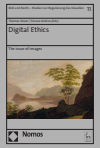Zusammenfassung
Digitale Bilder werfen ethische Fragen auf, die bislang kaum Aufmerksamkeit gefunden haben. Die diskreten Pixel digitaler Bilder lassen sich frei kombinieren. Zugleich ermöglicht das Netz eine im Vergleich zur Verbreitung analoger Bilder ungleich größere Kontrolle. Die Folgen für die visuelle Gegenwartskommunikation wie auch für das kulturelle visuelle Gedächtnis sind erst in Umrissen erkennbar. Kann es überhaupt eine angewandte Ethik digitaler Bilder geben? Welchen Inhalt könnte eine solche normative Ethik haben? Und schließlich: In welchem Verhältnis stehen Ethik und das Recht digitaler Bilder zueinander? Der Band versammelt die Beiträge einer von der DFG geförderten interdisziplinären deutsch-italienischen Tagung in der Villa Vigoni. Mit Beiträgen von Prof. Gianmaria Ajani, Prof. Tiziana Andina, Dr. Eva-Maria Bauer, Dr. Davide Dal Sasso, Prof. Dr. Thomas Dreier, PD Dr. Johannes Eichenhofer, Prof. Maurizio Ferraris, Prof. Dr. Christophe Geiger, Prof. Dr. Dr. h.c. Werner Gephart, Olivia Hägle, Prof. Wybo Houkes, Dr. Lisa Käde, Prof. Massimo Leone, Lorenz Müller-Tamm, Dr. Eberhard Ortland, Prof. Dr. Benjamin Raue, Ass. Prof. Cosetta Saba, Prof. Dr. Reinold Schmücker, Ass. Prof. Enrico Terrone und Prof. Dr. Wolfgang Ullrich.
Abstract
Digital images raise ethical issues that have so far received only little attention. The discrete pixels of digital images can be freely combined. Compared to the dissemination of analog images the net enables dis-proportionately greater control over how digital images are to be distributed. As of today, the consequences for contemporary visual communication as well as for the cultural visual memory are all but clear. Can there be an applied ethics of digital images at all? What could be the content of such a normative ethics? And what is the relationship between ethics and the law of digital images? This volume brings together the contributions to an interdisciplinary German-Italian conference at Villa Vigoni, sponsored by the DFG. With contributions by Prof. Gianmaria Ajani, Prof. Tiziana Andina, Dr. Eva-Maria Bauer, Dr. Davide Dal Sasso, Prof. Dr. Thomas Dreier, PD Dr. Johannes Eichenhofer, Prof. Maurizio Ferraris, Prof. Dr. Christophe Geiger, Prof. Dr. Dr. h.c. Werner Gephart, Olivia Hägle, Prof. Wybo Houkes, Dr. Lisa Käde, Prof. Massimo Leone, Lorenz Müller-Tamm, Dr. Eberhard Ortland, Prof. Dr. Benjamin Raue, Ass. Prof. Cosetta Saba, Prof. Dr. Reinold Schmücker, Ass. Prof. Enrico Terrone and Prof. Dr. Wolfgang Ullrich.
Schlagworte
Algorithmen Bild Bildethik Digitalisierung Fälschung Kopie Kunst Künstliche Intelligenz Information Deep Fakes technische Schutzmechanismen Bild und Recht digitale Bilder Angewandte Ethik- 187–270 Part 4 Binary Encoding, Artificial Intelligence and the Dissolution of the Visual Object 187–270
- 207–228 Chapter 12 From Copy & Paste to Deep Fakes – Digital Collaging and Image Manipulation 207–228
- 239–252 Chapter 14 Portrait or Personal Data – The Rivalry of Image and Data Protection Legislation 239–252
- 253–270 Chapter 15 Human Authorship and Art Created by Artificial Intelligence – Where Do We Stand? 253–270
- 417–426 About the authors 417–426

